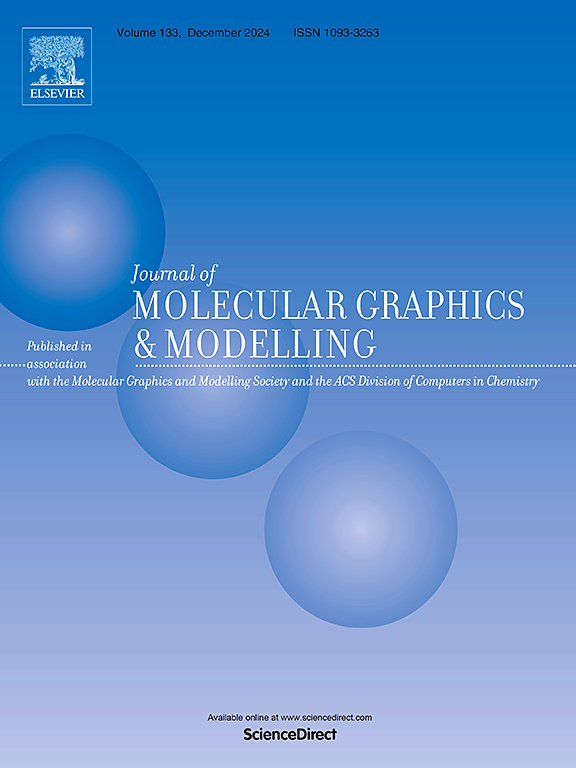Effect of metal ions in Baijiu on cluster formation of water, ethanol, acetic acid and ethyl acetate molecules: Molecular dynamics and density functional theory studies
IF 3
4区 生物学
Q2 BIOCHEMICAL RESEARCH METHODS
引用次数: 0
Abstract
Metal ions in Baijiu play an important role in the formation of liquor flavor, but their molecular mechanism has not been studied yet. In this study, molecular dynamics was used to calculate the radial distribution function (RDF), coordination number, and mean square displacement (MSD) of K+, Ca2+, and Fe2+ in water, ethanol, acetic acid, and ethyl acetate systems. Density functional theory was used to determine the binding energy, geometric configuration, and charge distribution of different clusters. The results of the MSD and RDF indicate that Ca2+ and Fe2+ are easily encapsulated by water or ethanol molecules in the system, resulting in weaker diffusion ability than K+. The interaction energy between K+, Ca2+, and Fe2+ and each molecule in the system increases sequentially, especially for Fe2+, which significantly changes the charge of molecules in the cluster. There are hydrogen bonds between molecules in clusters formed with K+ as the core, but there are no hydrogen bonds between molecules in clusters formed with Ca2+ and Fe2+ as the core. The cohesion of clusters formed with K+, Ca2+, and Fe2+ as the core increased in that order. The results of this study lay a theoretical foundation for understanding the molecular mechanism of metal ions in Baijiu.

白酒中金属离子对水、乙醇、乙酸和乙酸乙酯分子簇形成的影响:分子动力学和密度泛函理论研究。
白酒中的金属离子在白酒风味的形成中起着重要作用,但其分子机制尚未研究透彻。本研究采用分子动力学方法计算了K+、Ca2+和Fe2+在水、乙醇、乙酸和乙酸乙酯体系中的径向分布函数(RDF)、配位数和均方位移(MSD)。利用密度泛函理论确定了不同簇的结合能、几何构型和电荷分布。MSD和RDF结果表明,Ca2+和Fe2+在体系中容易被水或乙醇分子包封,扩散能力弱于K+。K+、Ca2+、Fe2+与体系中各分子的相互作用能依次增大,特别是Fe2+的相互作用能显著地改变了团簇中分子的电荷。以K+为核心形成的团簇中分子间存在氢键,而以Ca2+和Fe2+为核心形成的团簇中分子间不存在氢键。以K+、Ca2+、Fe2+为核心形成的团簇内聚力依次增大。本研究结果为理解白酒中金属离子的分子机制奠定了理论基础。
本文章由计算机程序翻译,如有差异,请以英文原文为准。
求助全文
约1分钟内获得全文
求助全文
来源期刊

Journal of molecular graphics & modelling
生物-计算机:跨学科应用
CiteScore
5.50
自引率
6.90%
发文量
216
审稿时长
35 days
期刊介绍:
The Journal of Molecular Graphics and Modelling is devoted to the publication of papers on the uses of computers in theoretical investigations of molecular structure, function, interaction, and design. The scope of the journal includes all aspects of molecular modeling and computational chemistry, including, for instance, the study of molecular shape and properties, molecular simulations, protein and polymer engineering, drug design, materials design, structure-activity and structure-property relationships, database mining, and compound library design.
As a primary research journal, JMGM seeks to bring new knowledge to the attention of our readers. As such, submissions to the journal need to not only report results, but must draw conclusions and explore implications of the work presented. Authors are strongly encouraged to bear this in mind when preparing manuscripts. Routine applications of standard modelling approaches, providing only very limited new scientific insight, will not meet our criteria for publication. Reproducibility of reported calculations is an important issue. Wherever possible, we urge authors to enhance their papers with Supplementary Data, for example, in QSAR studies machine-readable versions of molecular datasets or in the development of new force-field parameters versions of the topology and force field parameter files. Routine applications of existing methods that do not lead to genuinely new insight will not be considered.
 求助内容:
求助内容: 应助结果提醒方式:
应助结果提醒方式:


